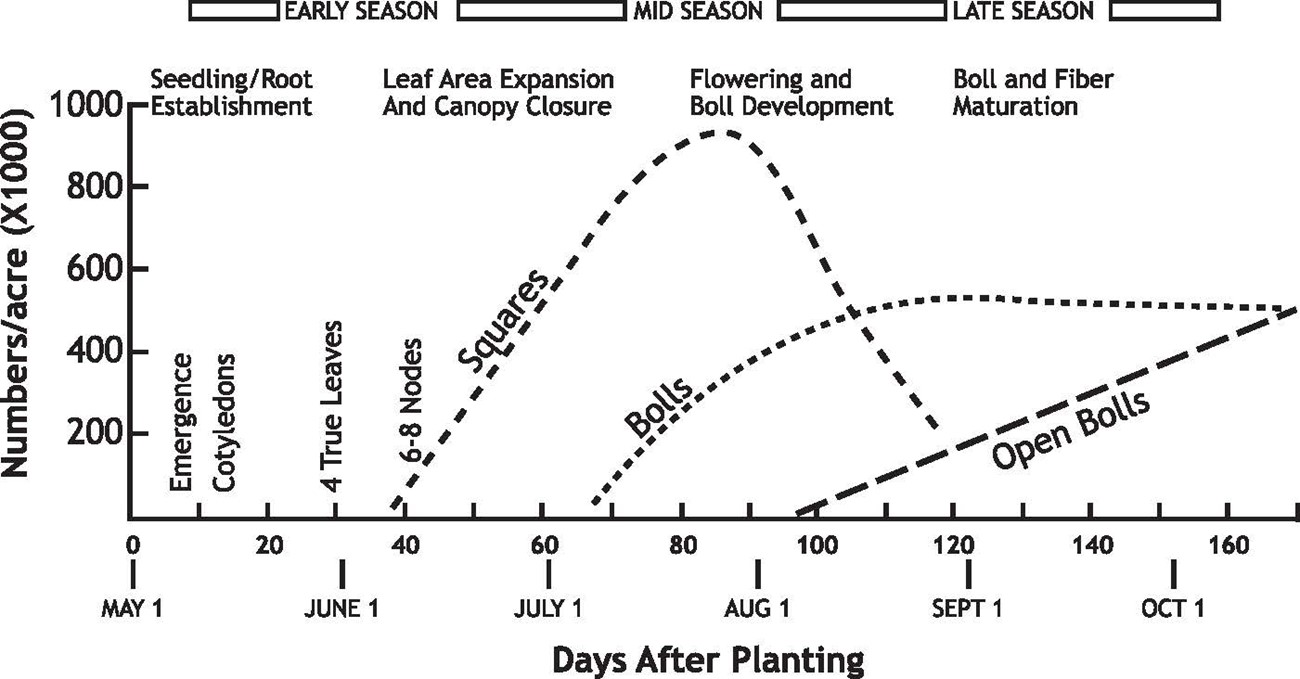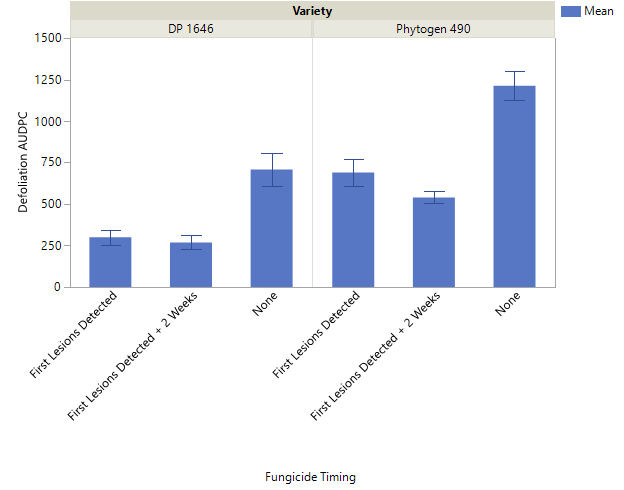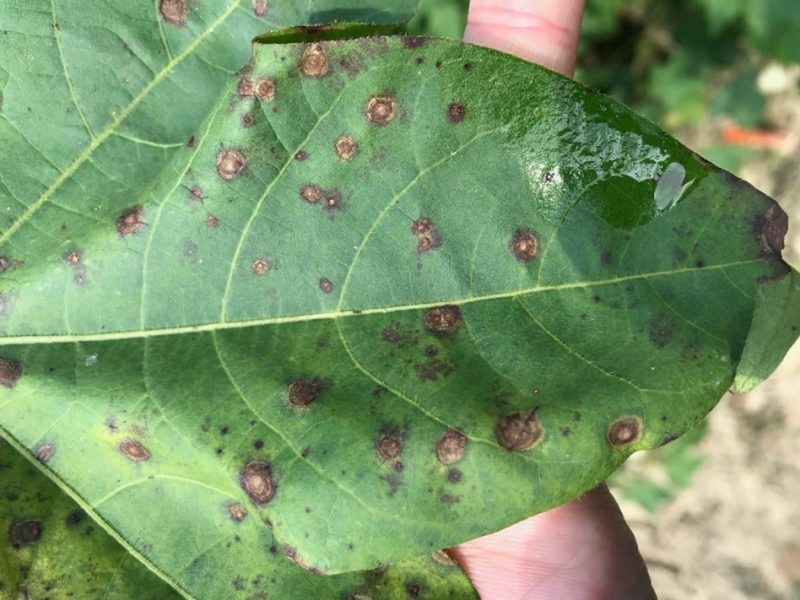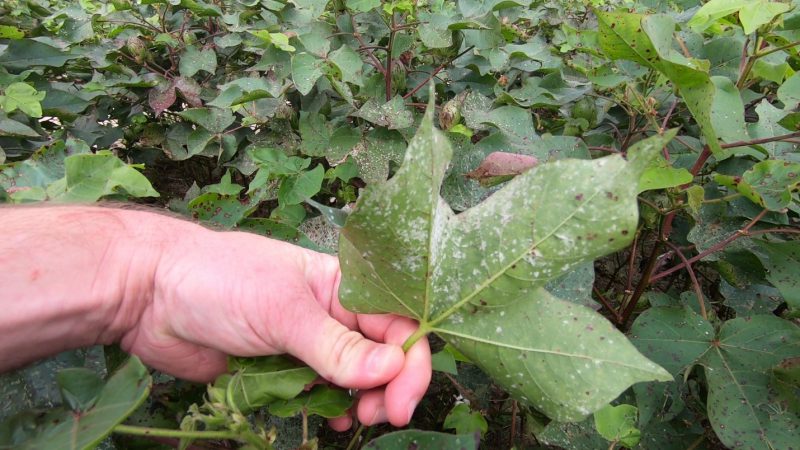Ian Small, UF/IFAS Crop Pathology Specialist, Bob Kemerait, UGA Crop Pathology Specialist, and Matthew Burger,UF/IFAS Plant Pathology Graduate Student
As most cotton growers in the Southeast approach mid-season, now is the time to be scouting for foliar diseases that can cause yield loss. Cotton is affected by several foliar diseases, with two notable ones being target spot and areolate mildew. If weather conditions are favorable and the variety of cotton you are growing is susceptible to either of these diseases, they can cause significant premature defoliation that can lead to yield loss. The key to preventing yield loss is to protect the crop during the flowering period and while boll development is occurring.
–
Target Spot
Target spot is caused by the fungal pathogen Corynespora cassiicola. Target spot is relatively easy to recognize in the field, due to the characteristic lesions with concentric rings that give it its name – target spot (Figure 1). Look for the initial lesions deep in the interior of the canopy. Corynespora cassiicola infects many host plants, including tomato, cucumber, hydrangea, soybeans, garden beans, and cotton. However, just because you have target spot affecting the tomatoes in your vegetable garden, it doesn’t necessarily pose a risk to your cotton. This is because there is diversity in the host specificity of Corynespora cassiicola. Isolates of this species are picky, and an isolate that is infectious to tomatoes is unlikely to infect cotton. Target spot of cotton tends to be a problem that affects high yield potential cotton, especially if there is rank growth. This is because fertility inputs and irrigation result in large cotton plants and a dense canopy. A dense canopy and rank growth results in a favorable microclimate for disease to develop. Typically, the disease is initiated on leaves in the lower canopy. The disease then progresses up the plant resulting in defoliation of leaves that would normally contribute to boll development. Subtending leaves, the leaf closest to a square or boll on a fruiting branch, are a major source of photosynthates required for boll development. If these subtending leaves are impacted by disease, it can affect boll development. The critical phase to protect against premature defoliation is during the flowering and boll development (Figure 2). This disease is common, but does not cause significant yield loss every season. Yield loss of 150 to 200 lb of lint/acre have been observed in target spot field trials in Florida and Georgia.

Figure 2. Phases of cotton development. Credit: Derrick M. Oosterhuis, (1990). Growth and development of a cotton plant. Nitrogen nutrition of cotton: Practical issues, pages 1-24.
–
Growers most likely to see benefit from applying fungicide for target spot have a crop with 1) high yield potential, 2) excellent growth, 3) disease appears at or soon after first bloom, and 4) grower makes fungicide application by 3rd week of bloom. Growers least likely to see a benefit from a fungicide application are those who a) have poor growth and a crop suffering from nutrient deficiency, b) apply fungicide where target spot never develops, c) apply fungicide after target spot has caused 25% or more defoliation.
From field research, we know that well timed fungicide applications can prevent significant yield loss. The general recommendation is to scout for disease and if you find target spot lesions developing before the sixth week of bloom, it is advisable to make a fungicide application and possibly a second application 14 days later, if conditions are favorable. Fungicide applications at the first and third week of bloom have been shown to be optimal timing for prevention of premature defoliation. After the sixth week of bloom the economic return on fungicide application begins to decline.

Figure 4. Impacts of variety and fungicide application timing on premature defoliation due to target spot of cotton. Varieties were Deltapine 1646 (moderately resistant to target spot) and Phytogen 490 (susceptible). The fungicide used for this study was Priaxor® (fluxapyroxad + pyraclostrobin) @ 4oz./acre.
–

Figure 5. Seed cotton yields for a field experiment investigating the effect of variety and fungicide timing on target spot development. Varieties were Deltapine 1646 (moderately resistant to target spot) and Phytogen 490 (susceptible). The fungicide used for this study was Priaxor® (fluxapyroxad + pyraclostrobin) @ 4oz./acre.
–
Areolate Mildew
Areolate mildew is another foliar pathogen of cotton caused by Ramulariopsis species. It produces distinctive fungal growth similar to other mildews encountered on crops such as cucurbit mildews. This disease can be easily identified by the presence of white to grayish colored spores on the underside of the leaf (Figure 3). For some varieties the upper leaf surface of infected leaves turns a purple color. However, there is a notable distinction between areolate mildew and other mildews that we commonly think of, such as powdery mildew of pumpkin. Powdery mildew of pumpkin is known as an obligate parasite, meaning that it requires living host tissue to complete its life cycle. If you were to try to grow the pathogen that causes powdery mildew on nutrient media in a petri dish it would not survive. Areolate mildew is also known as a false mildew, and it is able to grow on nutrient media without the presence of a living host. Because of this ability to live on non-living residue, areolate mildew can persist on decomposing plant material. Areolate mildew can cause premature defoliation, but fortunately the disease can be managed with timely fungicide application.
–
For a guide to diagnosing foliar diseases of cotton, read this helpful resource from Cotton Incorporated: Diagnosis and Management of Foliar Diseases in the United States.
You can also watch the following video on common foliar disease of cotton in Florida:
- Managing Peanut Health and Diseases in the Winter - January 31, 2025
- Bridging the Gap: Empowering Youth with Ag-Tech Skills - July 16, 2024
- Time to Protect your Cotton from Premature Defoliation due to Foliar Diseases - July 30, 2021


